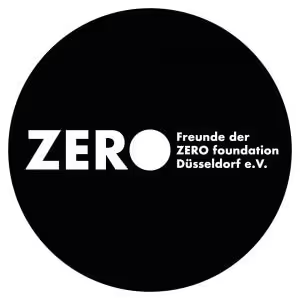A bright new start in the 1950s: The ZERO artist movement is in tune with the times

ZERO stands for the zero hour of art. A consistent break with existing conventions and traditions awakens novel concepts and aesthetic considerations in which light, structure and movement dominate. Heinz Mack, Otto Piene and Günther Uecker questioned the principles of art from the end of the 1950s to the mid-1960s and ventured into new things. In doing so, they created one of the most important avant-garde movements of the 20th century, renewed the understanding of art and have received positive feedback worldwide to this day.
Everything at the beginning: Cultural vacuum requires a fresh start
United by the common conviction that fundamental change was necessary in the post-war German period, Heinz Mack and Otto Piene joined forces in 1957 — the Düsseldorf art movement ZERO was born. Günther Uecker joined in 1961.
Together, they stand for a confident view of the future and the spirit of optimism for progress. They dare to take an experimental approach to art and explore new types of creative processes. At the same time, ZERO stood for a political stance at the beginning of the 1960s: post-war society, just like post-war art, must free itself from ballast. And the cultural and social vacuum created by the destructive forces of war must be filled with confidence. Technical achievements and modern civilization are seen as the basis for an optimistic view of the future.
ZERO became publicly visible and effective at the end of the 1950s through a series of exhibitions and lectures in Düsseldorf, as well as the exhibition catalogues of the same name ZERO 1 to 3. Further important ZERO exhibitions in Germany and Europe will follow. Central concerns for the founding members are the shared experience of art, intercultural exchange and mutual inspiration.
Light and movement as central leitmotifs in art
In its appearance, ZERO art cannot be squeezed into narrowly defined patterns or genres — rather, it blurs the boundaries between painting, sculpture, object art and installations. At the same time, each founding member has retained a very individual, characteristic style: Heinz Mack is known for his light-reflecting metal work, Piene focused on the power of color and Günther Uecker made his unique nail art a distinctive feature.
Connectedness and parallels can be found in the underlying motifs, as well as the common understanding of art: All three use elementary materials such as fire, water, glass or metal as materials and see art not as a work but as a design. In the spirit of kinetic art, Mack, Piene and Uecker see movement as an integral aesthetic component of every art object. The aim is to make optical phenomena and air movements visible in order to expand the viewer's conscious perception — movements should combine sensuality with rationality. Another central design theme of the ZERO Group is light. Quite directly in the literal sense, but also metaphorically and philosophically — as a symbol of hope and confidence.
ZERO stands for novel principles and ideas in which permanent experimentation with material, movement and light overcome the traditional understanding of art and creates a new, purist aesthetic. In doing so, the group shaped a new understanding of art and influenced the optical art (op art) of the 1960s/70s: geometric color figures that create the idea of movement through optical illusions.
In addition to artistic work in the studio, ZERO is characterized by joint activities and exchange with other artists. The most influential artists associated with the ZERO movement in addition to permanent members Mack, Piene and Uecker are Hans Salentin, Lucio Fontana, Yves Klein, Piero Manzoni and Jean Tinguely.
“I eat ZERO, I drink ZERO, I sleep ZERO, I wake ZERO, I love ZERO. ZERO is beautiful.”
- Excerpt, ZERO Manifesto (1963)
Reminiscent of futuristic proclamations, the ZERO Manifesto was published in 1963. In 1966, ZERO disbanded as part of a big celebration in Düsseldorf: More than a thousand people travel towards the Rhine in a burning car and letting it sink into the floods there. They celebrate liberation and light together. Mack, Piene and Uecker describe the dissolution of the group as a natural reaction to the separation of their artistic and biographical paths.
However, the ZERO movement has by no means come to a standstill: The international response is still great, and the search for new paths is omnipresent. Thanks to worldwide followers, ZERO's influence remains omnipresent to this day.
ZERO has already worked closely with some groups during their existence — such as the Dutch group NUL. Others worked in parallel and without direct connection on comparable motifs and approaches, such as the Japanese Artists' Association Gutai. Individual artists who work with light and natural phenomena can also be attributed to ZERO influences. These include Olafur Eliasson, with his physical phenomena of art, Dan Flavin with his light installations, and Tony Cragg with the creation of sculptures and spaces of experience.
ZERO remains immortal: Internationally networked center and foundation ensure the preservation of art and movement
Fifty years after the official dissolution, Mack, Piene and Uecker founded the Museum Kunstpalast Foundation in 2008 ZERO foundation, as a charitable foundation under public law.
It acts as an internationally networked center of scientific research to preserve ZERO art and movement. All three artists contributed numerous works to the foundation, which are now being exhibited worldwide. With the Düsseldorf ZERO House, the art movement has also found a permanent home, where lectures, film screenings and exhibitions take place regularly. Where Mack, Piene and Uecker created their works in the early 1960s and Piene lived and worked from 1975 until his death in 2014, the ZERO Foundation moved in with its archive in 2018.



